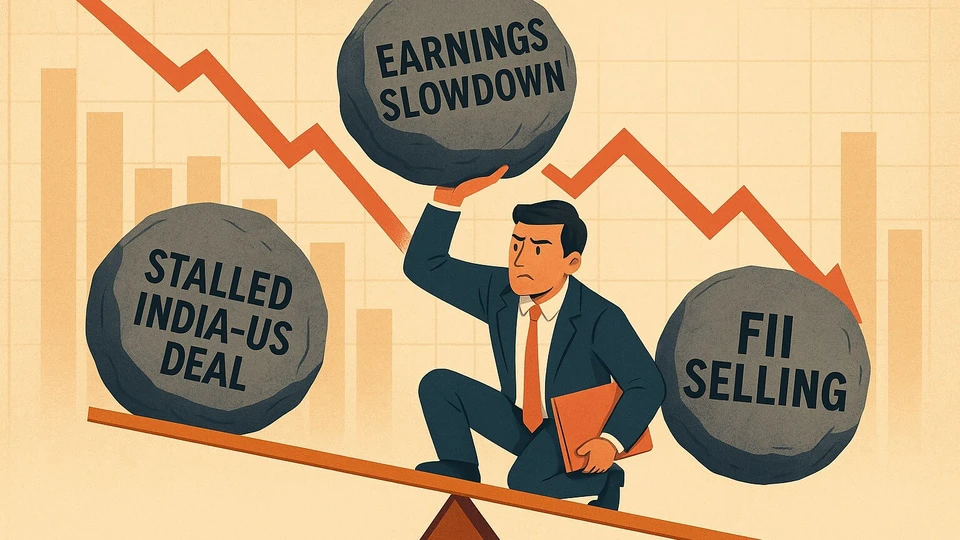Indian stock market: It would not be wrong to categorise 2025 as the year of extremes – as investors experienced a significant selloff in the first quarter of the year, followed by a sharp rally in the next and now the market has seemed to enter a no man’s land, with the bulls and bears locked in a fierce tussle.
The Indian economic setup, with strong GDP growth and low inflation, is keeping downside in check.
Why are Indian markets rising despite headwinds?
Helped by improving prospects for summer-sown crops, strong momentum in the services sector, and modest growth in industrial activity, the Indian economy has remained resilient against outside shocks, the RBI has stated. Moreover, India’s retail inflation rate eased to 2.10% in June, a six-year low, providing more room for the central bank to cut rates.
However, investors still face headwinds in the form of selling by foreign portfolio investors, slowdown in the India Inc earnings and a lack of progress in the India-US trade deal. This triple whammy threatens the stability of the Indian stock market.
There is an undercurrent of resilience in the market despite the elevated valuations. Two factors are providing this resilience to the market, said Dr VK Vijayakumar, Chief Investment Strategist, Geojit Investments.
One, he said, is the bullishness in the mother market US, which is providing psychological support to the bulls. Second, the liquidity support to the market continues unabated as DIIs, flush with funds, have been buyers in most of the sessions in July and have neutralised FII selling, Vijayakumar added.
What stock market risks are ailing investor portfolios?
However, he added that an area of concern in the near-term is the uncertainty regarding an interim trade deal between the US and India. “If India doesn’t get a favourable deal with tariffs below 20% that would be a short-term negative from the market perspective,” he said.
Reports indicated that the fifth round of talks ended without a breakthrough, dimming hopes of an interim trade deal. The US delegation is expected to visit India in mid-August to resume negotiations.
These deliberations are important as both sides are looking at finalising an interim trade deal before August 1, which marks the end of the suspension period of Trump tariffs imposed on dozens of countries, including India (26%).
“Investors are pricing in volatility not because of bad news-but due to the absence of clear direction. A tariff hike below 20% on Indian goods might even be digested positively, while anything higher could cause a knee-jerk reaction. However, the Street knows the US cannot sustain such high tariffs without facing domestic backlash or inflationary pressure,” said Harshal Dasani, Business Head, INVasset PMS.
Additionally, with markets being a slave to earnings, the early trends paint a poor picture. According to an Economic Times report, earnings growth has hit 9-quarter low amid the lacklustre performance of banking, finance, fast-moving consumer goods, and IT companies.
So far in 2025, the Sensex and Nifty 50 have held their ground despite the FPIs offloading stocks worth over ₹79,000 crore till July 23. While domestic liquidity provides resilience, the lack of inflows from FPIs will keep upside in check.
Market Strategy: How to trade amid near-term headwinds?
Analysts believe these risks will keep markets rangebound for some time, with the best strategy being to be selective and manage risk.
“Near-term headwinds in the form of FII selling, uncertainty around India-US trade deal and softness in the early Q1 earnings trend, might keep the market range-bound with bouts of volatility around key events such as the Fed and RBI’s interest rate decision and developments in the India-US trade talks. That said, India’s macroeconomic stability, resilient domestic flows, and strong reform momentum remain firmly intact,” said Divya Agrawal, Research Analyst & Advisory (Fundamental), Wealth Management, Motilal Oswal Financial Services.
She said that rather than turning defensive, we recommend staying selectively invested in fundamentally strong companies with clear earnings visibility. “Market corrections in such phases often present attractive entry points into high-conviction ideas.”
Puneet Sharma- CEO and Fund Manager at Whitespace Alpha- CAT 3 AIF, believes that in the current environment, trying to predict direction is more guesswork than strategy. What works instead is staying market-neutral, focusing on short-term inefficiencies, and managing risk tightly, he said.
He also advised letting discipline take precedence over conviction, while trying to compound steadily and protecting capital.
In the current environment, Dasani recommends positioning in domestic, policy-linked themes like defence, railways, and power, along with selective accumulation in small caps, remains the best course. Clarity-not comfort-will drive the next leg, he said.
